Ncert solution of Coordination compounds: This is the chapter in which we read about complex compounds. These compounds are vital and play important roles in our life. The topics of this chapter are very important for the students who are preparing for board exams, Neet, Jee(mains),IIT advance and some other competitive exams. We shall learn to solve all the intext and exercise questions in this article. Hence, you all are requested to remain till the end of this article. Hence, you all are requested to remain till the end of this article.
Coordination compounds is a very interesting chapter where we have to learn nomenclature, isomerism, shape, colour, magnetic moment and use in our daily life. We shall also know about Werner’s theory, Valence bond theory and Crystal field theory and their application to understand the composition and properties of coordination compounds.
Learning Objectives in Ncert solution of Coordination compounds
The focus points to give attention in the Ncert Solution of Coordination compounds are followings:
- To appreciate the postulates of Werner’s theory of coordination compounds.
- To know the meaning of the terms like coordination entities, central atom/ion, ligands, coordination number, coordination sphere, coordination polyhedron, oxidation number, homoleptic and hetroleptic complexes.
- To learn the rules of nomenclature of coordination compounds.
- To write the formulas and names of mononuclear coordination compounds.
- To define different types of isomerism in coordination compounds.
- To understand the nature of bonding in coordination compounds in terms of Valence bond and Crystal Field theory .
- To learn the stability of coordination compounds.
- To appreciate the importance and applications of coordination compounds in our day to day life.
Answers of Intext questions in Ncert Solution of Coordination compounds
Question 1. Write the formulas for the following coordination compounds:
(i)Tetraamminediaquacobalt(IlI) chloride
(ii)Potassium tetracyanidonickelate(II)
(iii)Tris(ethanp-1,2-diamine) chromium(III) chloride
(iv)Amminebromidochloridonitrito-N- platinatc(II)
(v)Dichloridobis(ethane-l ,2-diamine) platinum (IV) nitrate
(vi)Iron(III)hexacyanidoferrate(II)
Answer: (i) [CO(NH3)4(H2O)2]Cl3.
(ii)K2[Ni(CN)4]
(iii)[Cr(en)3]Cl3
(iv)[Pt (NH3) Br Cl (N02)]–
(v)[PtCl2(en)2](N03)2
(vi)Fe4[Fe(CN)6]3
Question 2. Write IUPAC names of following co-ordination compounds :
(a) [CO(NH3)6]Cl3
(b) [CO(NH3)Cl]Cl2
(C) K3[Fe(CN)6]
(d) [K3[Fe(C2O4)3]
(e) K2[PdCl4]
(f) [Pt(NH3)2ClNH2CH3]Cl.
Answer: (a) hexaamminecobalt (III) chloride
(b) pentaamminechloridocobalt (III) chloride
(c) potassium hexacyanoferrate (III)
(d) potassium trioxalatoferrate (III)
(e) potassium tetrachloridoplatinum (II)
(f) diamminechlorido (methylamine) platinum(II) chloride.
Question 3. Indicate the types of isomerism exhibited by the following complexes and draw the structures for these isomers:
(i)K[Cr(H2O)2(C2O4)2]
(ii)[CO(en)3]Cl3
(iii)[CO(NH3)5(NO2)(NO3)2], .
(iv)[Pt(NH3)(H2O)Cl2]
Answer: (i)(a) geometrical isomerism (cis and trans) will be exhibited as:
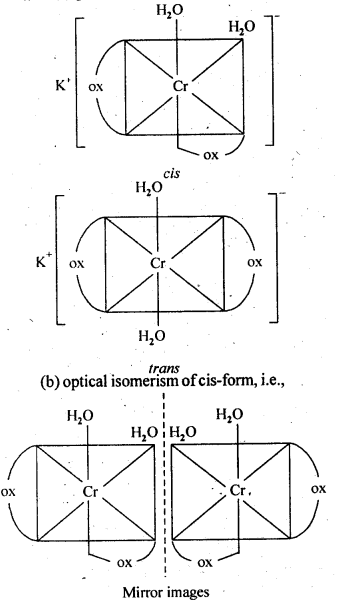
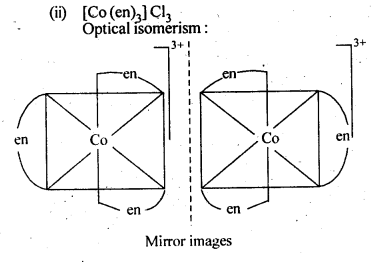

Question 4. Give evidence that [Co(NH3)5Cl]S04 and [Co(NH3)5S04]Cl are ionisation isomers.
Answer: When these compounds are dissolved in water, they produce different ions in solution which can be detected by adding AgN03 solution and BaCl2 solution, i.e., 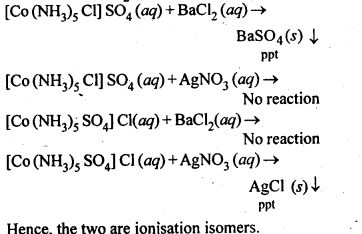
Question 5. Explain on the basis of valence bond theory that [Ni(CN)4]2- ion with square planar structure is diamagnetic and [NiCl4]2- ion with tetrahedral geometry is paramagnetic.
Answer: Outer electronic configuration of nickel (Z = 28) in ground state is 3d84s2. Nickel in this complex is in + 2 oxidation state. It achieves + 2 oxidation state by the loss of the two 4s-electrons. The resulting Ni2+ ion has outer electronic configuration of 3d8. Since CN– ion is a strong field, under its attacking influence, two unpaired electrons in the 3d orbitals pair up. 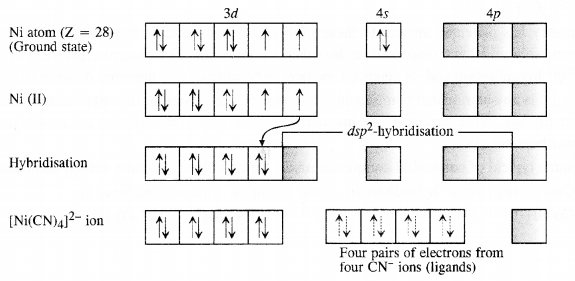
Outer electronic configuration of nickel (Z = 28) in ground state is 3d84s2 Nickel in this complex is in + 2 oxidation state. Nickel achieves + 2 oxidation state by the loss of two 4s-electrons. The resulting Ni2+ ion has outer electronic configuration of 3d8. Since Cl– ion is a weak field ligand, it is not in a position to cause electron pairing. 
Question 6. [NiCl4]2- is paramagnetic while [Ni(CO)4] is diamagnetic though both are tetrahedraL Why?
Answer: 
Question 7. [Fe(H2O)6]3+is strongly paramagnetic whereas [Fe(CN)6]3-is weakly paramagnetic. Explain.
Answer: 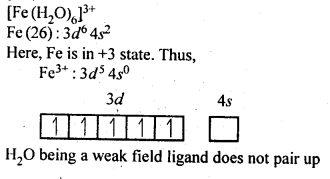

Question 8. Explain[CO(NH3)6]2+ is an inner orbital complex.whereas [Ni(NH3)6]2+ is an outer orbital complex.
Answer: 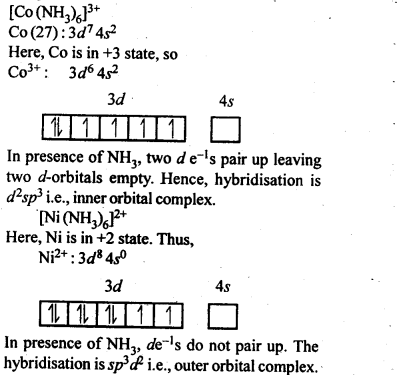
Question 9. Predict the number of unpaired electrons in the square planar [Pt(CN)4]2- ion.
Answer: 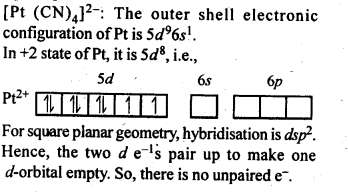
Question 10. The hexaaquamanganese (II) ion contains five unpaired electrons while the hexacyano ion contains only one unpaired electron. Explain using crystal field theory.
Answer: In the given compound Mn(II) ion has 3d5 configuration. In the presence of H2O molecules which acts as a weak field ligands, the distribution of these five electrons is t32ge2 i. e., all the electrons remain unpaired to form a high spin complex. However, in the presence of CN– which acts as strong field ligands, the distribution of these electrons is t52ge0g i.e., two t2g orbitals contain paired electrons while the third t2g orbital contains one unpaired electron. The complex formed is a low spin complex.
Question 11. Calculate the overall complex dissociation equilibrium constant for the Cu(NH3)42+ ion, given that β4 for this complex is 2.1 x 1013.
Answer: The overall stability constant (β4) = 2.1 x 1013 is given. Therefore, the overall dissociation constant will be as 
Answers of Exercise Questions in Ncert solution of Coordination compounds
Question 1. Explain the bonding in coordination compounds in terms of Werner’s postulates.
Answer: Werner’s postulates explain the bonding in coordination compounds as follows:
1. Primary and Secondary Valency:
- A central metal atom in a coordination compound has two types of valencies: primary and secondary.
- Primary valency is related to the oxidation state of the metal (usually satisfied by negative ions like Cl⁻, NO₃⁻).
- Secondary valency is the number of atoms or groups directly attached to the metal atom, which is called coordination number (these can be neutral molecules like H₂O or ions like NH₃).
2. Fixed Coordination Number:
- Each metal has a fixed coordination number (secondary valency), which determines how many ligands (atoms or groups) are bonded to the metal.
- These ligands form a specific structure around the metal, like a square planar, tetrahedral, or octahedral shape.
3. Direct Bonding with Ligands:
- The ligands are directly attached to the metal ion through secondary valencies, and they do not vary in the compound.
- These bonds are coordinate covalent bonds, where the ligands donate a pair of electrons to the metal atom.
4. Satisfaction of Valencies:
- Primary valencies are ionizable and can be satisfied by negative ions.
- Secondary valencies are non-ionizable and are satisfied by ligands that remain attached to the metal.
For example, in [Co(NH₃)₆]Cl₃, cobalt (Co) has a primary valency of +3, satisfied by three Cl⁻ ions, and a secondary valency of 6, satisfied by six NH₃ ligands.
Question 2. FeSO4 solution mixed with (NH4)2SO4 solution in 1:1 molar ratio gives the test of Fe2+ but CuSO4 solution mixed with aqueous ammonia in 1:4 molar ratio does not give the test of Cu2+ ion. Explain why?
Answer: FeSO4 solution mixed with (NH4)2SO4 solution in 1:1 molar ratio forms a double salt, FeSO4 .(NH4)2SO4 . 6H2O (Mohr salt) which ionize in the solution to give Fe2+ ions. Hence, it gives the test of Fe2+ ions.
CuSO4 solution mixed with aqueous ammonia in 1:4 molar ratio forms a complex salt, with the formula [Cu(NH3)4]SO4. The complex ion, [Cu(NH3)4]2+ does not ionize to give Cu2+ ions. Hence, it does not give the tests of Cu2+ ions.
Question 3. Explain with two examples each of the followings: Coordination entity, ligand, coordination number, coordination polyhedron, homoleptic and heteroleptic.
Answer: Here’s a simple explanation with examples for each term:
1. Coordination Entity:
A coordination entity consists of a central metal atom or ion bonded to a fixed number of surrounding ions or molecules called ligands.
Examples: [Fe(CN)₆]⁴⁻: A complex with an iron (Fe2+) ion and six cyanide (CN⁻) ligands.
[Co(NH₃)₆]³⁺: A complex with a cobalt (Co3+) ion and six ammonia (NH₃) ligands.
2. Ligand: A ligand is an ion or molecule that donates a pair of electrons to the central metal atom or ion to form a coordinate bond. Examples:
Cl⁻ (Chloride ion): A negatively charged ligand.
NH₃ (Ammonia): A neutral ligand that donates a lone pair of electrons.
3. Coordination Number:
The coordination number is the number of ligand donor atoms directly attached to the central metal atom or ion in a coordination compound. Examples:
In [Co(NH₃)₆]³⁺, the coordination number is 6 (six NH₃ ligands).
In [PtCl₄]²⁻, the coordination number is 4 (four Cl⁻ ligands).
4. Coordination Polyhedron:
The coordination polyhedron is the spatial arrangement of the ligand atoms around the central metal atom, forming a specific geometric shape. Examples:
[Ni(CO)₄]: Forms a tetrahedral geometry with four ligands.
[Co(NH₃)₆]³⁺: Forms an octahedral geometry with six ligands.
5. Homoleptic Complex:
A homoleptic complex is a coordination compound in which the central metal is bonded to only one type of ligand. Examples:
[Co(NH₃)₆]³⁺: All ligands are ammonia (NH₃).
[Ni(CO)₄]: All ligands are carbon monoxide (CO).
6. Heteroleptic Complex:
A heteroleptic complex is a coordination compound in which the central metal is bonded to more than one type of ligand.
Examples:
[Cr(NH₃)₄Cl₂]⁺: Contains both NH₃ and Cl⁻ ligands.
[Pt(NH₃)₂Cl₂]: Contains NH₃ and Cl⁻ ligands.
Question 4. What is meant by Unidentate, didentate and ambidentate ligands? Give two examples for each.
Answer: 1. Unidentate Ligand:
A unidentate ligand is a ligand that can donate only one pair of electrons to the central metal atom, using only one donor atom. Examples:
Cl⁻ (Chloride ion): It uses its lone pair from the chlorine atom to bond with the metal.
NH₃ (Ammonia): It donates one lone pair from the nitrogen atom to the metal.
2. Didentate Ligand:
A didentate ligand is a ligand that has two donor atoms and can form two bonds with the central metal atom at the same time. Examples:
Ethylene diamine (en): It has two nitrogen atoms, each of which can donate a pair of electrons to the metal.
Oxalate ion (C₂O₄²⁻): It has two oxygen atoms that can both donate electron pairs to the metal.
3. Ambidentate Ligand:
An ambidentate ligand is a ligand that has two possible donor atoms, but it can use only one donor atom at a time to form a bond with the metal. Examples:
NO₂⁻ (Nitrite ion): It can bond through either the nitrogen atom (–NO₂) or the oxygen atom (–ONO).
SCN⁻ (Thiocyanate ion): It can bond through either the sulfur atom (–SCN) or the nitrogen atom (–NCS).
Question 5. Specify the oxidation numbers of the metals in the following coordination entities:
(i) [Co(H2O)(CN)(en)2]2+ (ii) [CoBr2(en)2]+ (iii) [PtCl4]2- (iv) K3[Fe(CN)6] (v) [Cr(NH3)3CI3]
Answer: (i) O.N. of cobalt be x, then x + 0 + (–1) + 0 = +2 or x = 3 (ii) O.N. of Co be x, then x +2(– 1) + 2(0) = +1 or x = +3. (iii) Let the O.N. of Pt be x, then x – 4 = – 2 or x = + 2 (iv) Let the O.N. of Fe be x, then 3 + x + 6(–1) = 0 or x = + 3. (v) Let the O.N. of Cr be x, then x + 3(0) + 3(–1) = 0 or x = + 3.
Question 6. Using IUPAC norms, write the formulae for the following :
(I) Tetrahydroxozincate(II)
(II) hexaammineplatinum (TV)
(III) potassiumtetrachloridopalladate(II)
(IV) tetrabromidocuprate (II)
(V) hexaaminecobalt(III) sulphate
(VI) potassiumtetracyanonicklate (II)
(VII) potassiumtrioxalatochromate(III)
(VIII) pentaamminenitrito-O-cobalt(III)
(IX) diamminedichloridoplatinum(II) (X) pentaamminenitrito-N-cobalt (III)
Answer: (I) [Zn(OH)4]2-
(II) [Pt(NH3)6]4+
(III) K2[PdCl4]
(IV) [Cu(Br)4]2-
(V) [CO(NH3)6]2 (SO4)3
(VI) K2[Ni(CN)4]
(VII) K3 [Cr(OX)3]
(VIII) [CO(NH3)5ONO]2+
(IX) [Pt(NH3)2Cl2]
(X) [CO(NH3)5NO2]2+.
Question 7. Using IUPAC norms write the systematic names of the following:
(i) [Co(NH3)6]CI3,
(ii)[Pt(NH3)2CI (NH2CH3)] Cl
(iii) [Ti(H20)6]3+
(iv) [Co(NH3)4Cl(N02)]CI
(v)|Mn(H20)6]2+
(vi)[NiCl4]2-
(vii)[Ni(NH3)6]CI2
(viii)[Co(en)3]3+
(ix) [Ni(CO)4]
Answer: (i) Hexaammine cobalt (III) chloride.
(ii) Diammine chlorido (methylamine) platinum (II) chloride.
(iii) Hexaaquatitanium (III) ion.
(iv) Tetraammine chlorido nitrito-N-cobalt (IV) chloride.
(v)Hexaaquamanganese (II) ion.
(vi)Tetrachloridonickelate (II) ion.
(vii)Hexaammine nickel (II) chloride.
(viii)Tris (ethane -1,2-diamine) cobalt (III) ion.
(ix) Tetra carbonyl nickel (0).
Question 8. List the various types of isomerism possible for coordination compounds, giving an example of each.
Answer: Types of Isomerism in Coordination Compounds:
Coordination compounds can exhibit different types of isomerism, classified into two broad categories: structural isomerism and stereoisomerism. Each type can be explained with examples as follows:
1. Structural Isomerism:
This arises when compounds have the same molecular formula but different arrangements of atoms or bonds.
(a)Ionization Isomerism: This occurs when a ligand in the coordination sphere exchanges places with an ion outside the coordination sphere.
Example: [Co(NH3)5Br]SO4) and [Co(NH3)5SO4]Br.
In one case, bromide is inside the coordination sphere, and sulfate is outside; in the other, the positions are reversed.
(b) Hydrate Isomerism: This isomerism occurs due to the exchange of water molecules between the coordination sphere and the outside environment.
Example: [Cr(H2O)6]Cl3) and [Cr(H2O)5Cl]Cl2·H2O.
In the first isomer, all water molecules are coordinated to the metal, while in the second, one water molecule is outside the coordination sphere.
(c) Linkage Isomerism: It arises when a ligand can coordinate to the metal through different atoms.
Example: [Co(NH3)5(NO2)]2+ and [Co(NH3)5(ONO)]2+.
Here, the nitrite ion (NO2–) can coordinate through nitrogen (as nitro, NO2) or oxygen (as nitrito, ONO).
(d) Coordination Isomerism: This type occurs in compounds where both the cation and anion are coordination complexes, and there is an interchange of ligands between them.
Example: [Co(NH3)6][Cr(CN)6] and [Cr(NH3)6][Co(CN)6].
The ligands are exchanged between the two metal centers.
2. Stereoisomerism:
This type arises when compounds have the same bonding sequence but differ in the spatial arrangement of atoms or groups.
(a) Geometrical Isomerism: This occurs when ligands can occupy different positions around the central metal atom. It is common in square planar and octahedral complexes.
Example: In [Pt(NH3)2Cl2], the ligands can either be adjacent (cis) or opposite each other (trans). In the cis isomer, the two ammonia molecules are next to each other, while in the trans isomer, they are opposite.
(b) Optical Isomerism: This arises in chiral compounds that cannot be superimposed on their mirror images.
Example: [Co(en)3]3+ (where “en” stands for ethylenediamine) forms two enantiomers, which are non-superimposable mirror images of each other.
Question 9. How many geometrical isomers are possible in the following coordination entities? (i) [Cr(C2O4)3]3— (ii) [CoCl3(NH3)3]
Answer: (i) No geometrical isomers are possible (ii) Two geometrical isomers as cis and trans.
Question 10. Draw the structures of optical isomers of (i) [Cr(C2O4)3]3– (ii) [PtCl2(en)2]2+ (iii) [Cr(NH3)Cl2(en)]+
Answer: 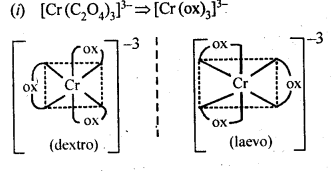

Question 11. Draw all the isomers (geometrical and optical) of
(i)[CoCl2(en)2]+
(ii)[Co(NH3) Cl (en)2]2+
(iii) [Co(NH3)2Cl2(en)]+
Answer: 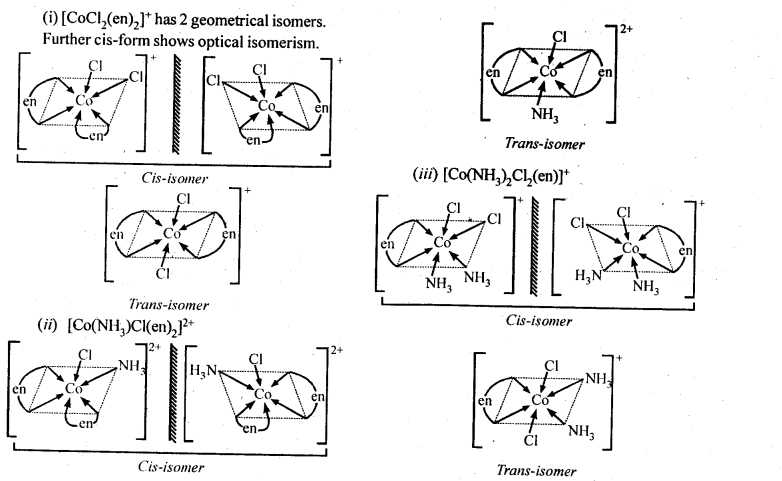
Question 12. Write all the geometrical isomers of [Pt(NH3)(Br)(Cl) (Py)] and how many of these will exhibit optical isomerism?
Answer: Three isomers are possible as follows: 
Isomers of this type do not show any optical isomerism. This isomerism only rarely occurs in square planar or octahedral complexes and that too when they contain unsymmetrical chelating ligands.
Question 13. Aqueous copper sulphate solution (blue in colour) gives: (i) a green precipitate with aqueous potassium fluoride and (ii) a bright green solution with aqueous potassium chloride. Explain these experimental results.
Answer: Aqueous CuS04 solution exists as [Cu(H20)4]S04 which has blue colour due to [Cu(H20)4]2+ ions.
(i) When KF is added, the weak H20 ligands are replaced by F– ligands forming [CUF4]2- ions which is a green precipitate. 
(ii)When KCl is added, Cl– ligands replace the weak H20 ligands forming [CuCl4]2- ion which has bright green colour. 
Question 14. What is the coordination entity formed when excess of aqueons KCN is added to an aqueous solution of copper sulphate? Why is it that no precipitate of copper sulphide is obtained when H2S (g) is passed through this solution?
Answer: At first cupric cyanide is formed which decomposes to give cuprous cyanide and cyanogen gas. Cuprous cyanide dissolves in excess of potassium cyanide to form the complex K3[Cu(CN)4], 
Thus, coordination entity formed in the above reaction is [Cu(CN)4]3-. As CN– is a strong ligand, the complex ion is highly stable and does not dissociate/ionize to give Cu2+ ions. Hence, no precipitate, with H2S is formed.
Question 15. Discuss the nature of bonding in the following coordination entities on the basis of valence bond theory:
(i) [Fe(CN)6]4-
(ii) [FeF6]3-
(iii) [Co(C2O4)3]3-
(iv) [CoF6]3-
Answer: 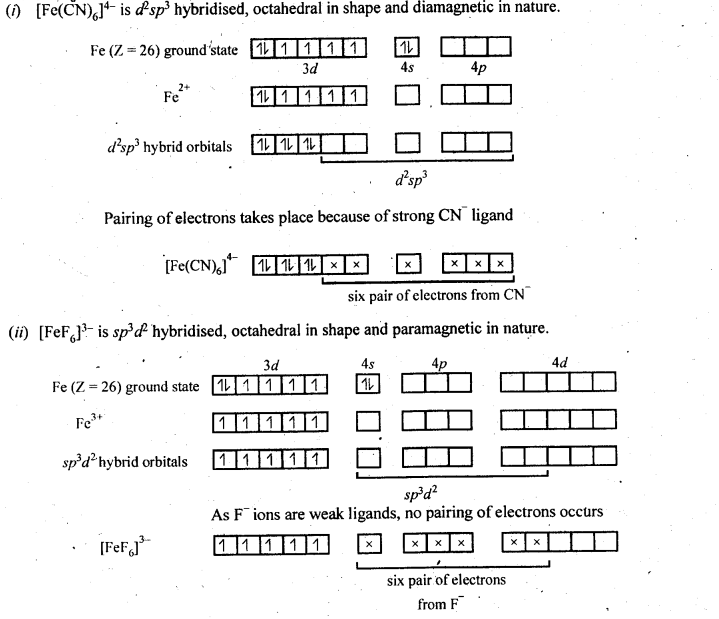
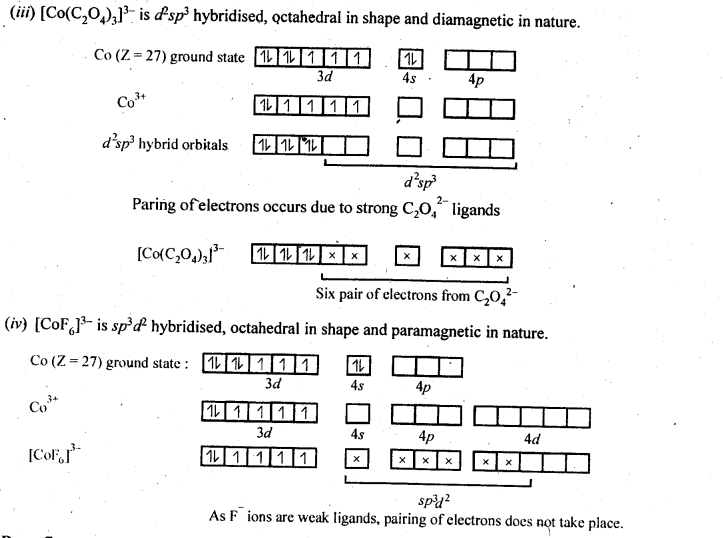
Question 16. Draw figure to show splitting of degenerated orbitals in an octahedral crystal field.
Answer: 
Question 17. What is spectrochemical series? Explain the difference between a weak field ligand and a strong field ligand.
Answer: Spectrochemical series. The arrangement of ligands in order of their increasing field strength or increasing crystal field splitting energy (CFSE) values is called Spectrochemical series. Difference between a weak field and a strong field ligand. The ligands with small value of CFSE (Δo) are called weak field ligands whereas those with large value of CFSE are called strong field ligands.
Question 18. What is crystal field splitting energy? How does the magnitude of Δo decide the actual configuration of d-orbitals in a coordination entity?
Answer: when ligands approach a transition metal ion, the d-orbitals split into two sets, one with lower energy and the other with higher energy. The difference of energy between the two sets of orbitals is called crystal field splitting energy (Δofor octahedral field).
If Δo< p (pairing energy), the 4th electron enters one of the eg orbitals giving the configuration t32g e1g thus forming high spin complexes. Such ligands for which Δo< p are called weak ligands.
If Δo> p (pairing energy), the 4th electron pair up in one of the t2g orbitals giving the configuration t42g e0g thus forming low spin complexes. Such ligands for which Δo> p are called weak ligands.
Question 19. [Cr(NH3)6]3+ is paramagnetic while [Ni(CN)4]2- is diamagnetic. Explain why?
Answer: 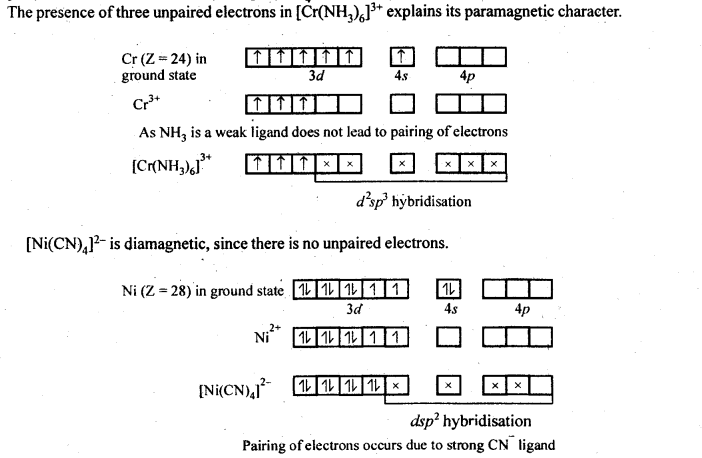
Question 20. A solution of [Ni(H20)6]2+ is green but a solution of [Ni(CN)4]2-is colourless. Explain.
Answer: In [Ni(H20)6]2+ , Ni is in +2 oxidation state with the Configuration 3d8 that means it has two unpaired electrons which do not pair up in the presence of the weak H2O ligand. Hence, it is coloured. The d-d transition, absorbs red light and the corresponding light emitted is green.
In case of [Ni(CN)4]2-, Ni is again in +2 oxidation state with the configuration of 3d8 but in presence of the strong CN– ligand, the two unpaired electrons in the 3d orbitals pair up. Thus, there is no unpaired electrons. Hence, it is colourless.
Question 21. [Fe(CN)6]4- and [Fe(H2O)6]2+ are of different colours in dilute solutions. Why?
Answer: In both the complex compounds, Fe is in +2 oxidation state with the configuration 3d6 that means it has 4 unpaired electrons. As the ligands H2O and CN– possess different crystal field splitting energy (Δo), they absorb different components of the visible light for d-d transition. Hence, the transmitted colours are different.
Question 22. Discuss the nature of bonding in metal carbonyls.
Answer: In metal carbonyl, the metal carbon bond (M – C) have both the σ and π -bond character. These bonds are formed by the overlap of atomic orbitals of metal with that of C-atom of carbon monoxide in following ways:
(a) At first σ -bond is formed between metal and carbon when a vacant d-orbital of metal atom overlaps with an orbital having lone pair of electrons on C-atom of carbon monoxide (: C = O:)
(b) Besides the σ -bond in metal carbonyl, the electrons from filled d-orbitals of a transition metal atom or ion are back donated into anti bonding π-orbitals of carbon monoxide. This tendency of ligand stabilises the metal ligand bonding. The above two concepts can be shown by the following figures: 
Question 23. Give the oxidation state, d-orbital occupation and coordination number of the central metal ion in the following complexes:
(i)K3[CO(C2O4)3 ] (ii) cis-[Cr(en)2Cl2]Cl (iii) (NH4)2[CoF4] (iv) [Mn(H20)6]SO4
Answer: (i) Oxidation state of Co in 3K+ [CO(C2O4)3 ]3-. x – 6 = –3 or x = +3 coordination number = 6 as ligand is didentate. d- orbital occupation = 3d6 or t62g e0g and unpaired electrons = 0
(ii) Oxidation state of Cr in cis-[Cr(en)2Cl2]Cl , x + 0 – 3 = 0 or x = + 3 Coordination number = 6 (en is didentate) d-orbital occupation = 3d3 = t32g and unpaired electrons =3
(iii) Oxidation state of Co in 2(NH4)+[CoF4]2- x — 4 = – 2 or x = + 2. Coordination number = 4. d- orbital occupation = 3d7 = e4 t32g and unpaired electrons = 3
(iv) Oxidation state of Mn in [Mn(H20)6] 2+SO4 2- , x – 0 = +2 or x = +2, Coordination number = 6, d-orbital occupation = 3d5 = t32g e2g and unpaired electrons = 5.
Question 24. Write down the IUPAC name for each of the following complexes and indicate the oxidation state, electronic configuration and coordination number. Also give stereochemistry and magnetic moment of the complex:
(i) K[Cr(H20)2(C204)2|-3H20 (ii) [Co(NH3)5CIlCl2 (iii) CrCI3(Py)3
(iv)Cs[FeCl4] (v)K4|Mn(CN)6|
Answer: (i) Potassium diaquadioxalatochromate(III) hydrate. Coordination number = 6, shape = octahedral. Oxidation state of Cr = x + 0 + 2(– 2) = – 1 or x = + 3. E.C. of Cr3+ = 3d3 = t32g e0g. Unpaired electrons (n) = 3. Magnetic moment (μ) = √n(n+2) = √3(3 + 2) = √15 BM = 3.87 BM.
(ii) pentaaminechloridocobalt(III) chloride. C.N. of Co = 6, shape = octahedral. O.S. of Co: x + 0 – 1 = +2 or x = + 3. E.C. of Co3+ = 3d6 = t62g e0g, n = 0 , μ = 0
(III)Trichlororidopyridinechromium(III). C.N. of Cr = 6, Shape = octahedral, O.S.of Cr: x – 3 + 0 = 0 or x = + 3. E.C. of Cr3+ = 3d3 = t32g e0g, n = 3 , μ = √n(n+2) = √3(3 + 2) = √15 BM = 3.87 BM.
(IV) Cesium tetrachloroferrate(III). C.N. of Fe = 4, Shape = tetrahedral. O.N. of Fe: x – 4 = – 1 or x = +3. E.C. of Fe3+ = 3d5 = e2 t32, n = 5, μ = √5(5+2 = √35 = 5.92 BM.
(V) Potassium hexacyanomanganate(II). C.N. of Mn = 6, Shape = octahedral. O.S. of Mn: x – 6 = – 4, x = + 2. E.C. of Mn2+ = 3d5 = t52g e0g, n = 1, μ = √1(1+2) = √3 = 1.73 BM.
Question 25. What is meant by stability of a coordination compound in solution? State the factors which governs stability of complexes.
Answer: Formation of a complex in any solution is an equilibrium reaction. It may be represented as M + 4 L ⇌ ML4 . The equilibrium constant of this reaction is the measure of stability of the complex. Hence the equilibrium constant is also called as stability constant or Instability constant may be defined as equilibrium constant for reverse reaction. The formation of above complex may also be written in successive steps: 
Now the stability constant can be written as:
β4=K1K2K3K4.
Greater the stability constant, stronger is the metal-ligand bond.
The stability of complex will depend on the following factors:
(a)nature of metal
(b)Oxidation state of metal
(c)Nature of ligand e g. chelating ligand form stabler complexes
(d)Greater the basic strength of the ligand, more will be the stability.
Question 26. What is meant by chelate effect? Give an example.
Answer: When a didentate or polydentate ligand contains donor atoms positioned in such a way that when they coordinate with the central atom ion, a five or six membered ring is formed. This effect is called chelate effect. Due to this effect, the stability of the complex compounds increases. For example: 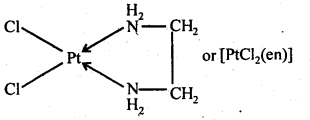
Question 27. Discuss briefly giving an example in each case the role of coordination compounds in. (a) biological systems (b) analytical chemistry (c) medicinal chemistry (d) extraction/metallurgy of metals.
Answer: The important role of the coordination compounds in the given fields are followings:
(a) Role of Coordination Compounds in Biological Systems:
Coordination compounds are vital in biological processes. A good example is hemoglobin in our blood. Hemoglobin contains iron at its center, which helps in binding and transporting oxygen throughout our body. Without this coordination compound, oxygen transport wouldn’t be possible.
(b) Role in Analytical Chemistry:
In analytical chemistry, coordination compounds help in detecting and measuring substances. For example, in complexometric titration, a coordination compound called EDTA is used to determine the concentration of metal ions like calcium and magnesium in a solution. EDTA forms stable complexes with these metals, which helps in accurate measurements.
(c) Role in Medicinal Chemistry:
Coordination compounds are also used in medicine. A well-known example is cisplatin, which is used as an anticancer drug. Cisplatin works by forming coordination bonds with DNA in cancer cells, stopping their growth and replication.
(d) Role in Extraction/Metallurgy of Metals:
In metallurgy, coordination compounds are used to extract metals from their ores. For instance, in the extraction of silver, the ore is treated with a solution of sodium cyanide, forming a soluble coordination complex with silver ions. This helps in separating silver from the rest of the material in the ore.
Question 28. How many ions are produced from the complex, Co(NH3)6Cl2 in solution? (i) 6 (ii) 4 (iii) 3 (iv) 2.
Answer: Coordination number of cobalt = 6. Hence, the complex is [Co(NH3)6Cl2 ]. It ionises in the solution as Co(NH3)6 2+ 2Cl– . Thus, three ions are produced. Hence, the correct answer is (iii).
Question 29. Amongst the following ions? Which one has the highest magnetic moment value:
(i) [Cr(H2O)6]3+ (ii) [Fe(H20)6]2+ (iii) [Zn(H20)6]2+
Answer: The oxidation states are as Cr(III) , Fe (II) and Zn (II) in the given compounds. E.C. of Cr3+ = 3d3, unpaired electrons = 3 (an inner orbital complex). E.C. of Fe2+ = 3d6, unpaired electrons = 4 (an outer orbital complex). E.C. of Zn2+ = 3d10, unpaired electrons = 0 (an outer orbital complex). As unpaired electrons ∝ magnetic moment. Hence (ii) option is correct.
Question 30. The oxidation number of cobalt in K[Co(CO)4] is
(i)+1 (ii)+3 (iii)-1 (iv)-3
Answer: This compound dissociate as K+ [Co(CO)4]–1 ∴ x + 0 = – 1 or x = –1. Hence, the option (iii) is correct.
Question 31. Amongst the following, the most stable complex is:
(i) [Fe(H2O)6] (ii) [Fe(NH3)6]3+
(iii) [Fe(C2O4)3]3- (iv) [FeCl6]3-
Answer: In each of the given complexes, Fe is in +3 oxidation. As (C2O4)2- is didentate chelating ligand. It forms chelate rings and hence compound of (iii) option is the most stable and this is the correct answer.
Question 32. What will be the correct order for the wavelengths of absorption in the visible region for the following:[Ni(NO2)6]4-, [Ni(NH3)6]2+, [Ni(H20)6]2+?
Answer: As metal ion is fired in every compound, the increasing field strength (CFSE values) of the ligands from the Spectrochemical series are in the order: H2O < NH3 < NO2–. Thus, the energies order will be as: [Ni(H20)6]2+ < [Ni(NH3)6]2+ < [Ni(NO2)6]4- As E ∝ 1/λ. Hence the order of wavelength (λ) will be in the opposite order.

